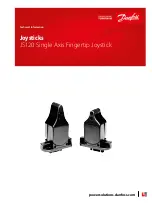
23
The security feature utilizes the authentication built into the browser. When a change to a parameter is
made the controller checks the programmed password. If a password is required the controller will re-
quest it from the browser and in turn the browser will prompt the user. The browser will request a
“
User
name
”
and
“
password
”.
Since the controller only contains one password (one user) the
“
User name
”
can be left blank. Once the password is entered it is returned to the controller were it will be checked
and if it is correct the parameters are saved. If it is incorrect the controller will request it from the brows-
er again.
After a password has been entered most browsers will cache it and return on subsequent request with-
out prompting the user. So as long as the browser is not closed it would not be necessary to enter the
password on every change to the parameters.
To remove a password from the controller it just needs to be set to a zero length string and saved via
the submit button. Of course this action requires the existing password. If the password is lost or un-
known contact your AIMCO representative for a method of retrieval.
FTP
The controller has the ability to provide an FTP server to allow the transfer of stored rundown data. For
security reason it is turned off by default.
Changing the setting to from off to on or on to off will not take
effect till power is cycled on the controller.
Once enabled the FTP server will allow anonymous
logins.
The only files available are the rundown results in CSV and TXT format.
These can be trans-
ferred to the client and deleted.
No other FTP server features are supported.
Toolsnet
The controller has the ability to send rundown data to a ToolsNet server. Once the controller is on the
local network there are five parameters that must be set to store data correctly on the server.
1.
Server IP Address:
This is the IP address of the Toolsnet server. If the server is on another
subnet you will also have to verify the gateway in the Ethernet settings.
2.
Server Port Number:
This is the TCP port the server is listening on for a new connection. The
default for this is 6547 but it should be verified with the local Toolsnet server administrator.
3.
Station Id:
This is used to identify the data in the Toolsnet database. Work with your local Tools-
net server administrator to set this correctly.
4.
System Number:
This is used to identify the data in the Toolsnet database. Work with your local
Toolsnet server administrator to set this correctly.
5.
Station Number:
This is used to identify the data in the Toolsnet database. Work with your local
Toolsnet server administrator to set this correctly.
PFCS
The controller has the ability to communicate over the Chrysler PFCS protocol over Ethernet or one of
the serial ports. Once the controller is connect to the desired network there are several parameters
used to configure it
’
s behavior on the PFCS network.
1.
Server IP Address:
This is the IP address of the PFCS server. If the server is on another sub-
net you will also have to verify the gateway in the Ethernet settings. This parameter is not used
for a serial connection to PFCS.
2.
Server Port Number:
This is the TCP port the server is listening on for a new connection. This
parameter is not used for a serial connection to PFCS.
3.
Ack Time Out (sec):
The amount of time the controller will wait for an acknowledge from the
PFCS server.
4.
No. Retries:
The number of times the controller will retry a message if it is not answered by the
PFCS server.
5.
Reconnect Time Out (sec):
The amount of time the controller will wait before attempting to re-
connect to the PFCS server.
6.
Connection Inactivity Time (sec):
The amount of time the controller will wait before send a keep
alive message.
7.
Auto Machine Id:
If set to a 1 the controller will request a machine ID from PFCS. If it is a 0 it
will use the programmed one from each parameter set.
Networking
Summary of Contents for iEC
Page 1: ...AcraDyne iEC DC Tool Controllers User Guide...
Page 35: ...35 Appendix B KDM Menu Structures Main Menu Structure Parameter Set up Menu...
Page 36: ...36 APPENDIX B KDM Menu Structures Administration Menu...
Page 45: ...45 Notes...
Page 46: ...46 Notes...
Page 47: ...47 Notes...
















































